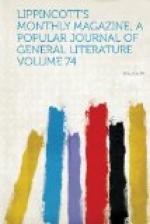In the opening of a small tent, then, we paused to watch an old moukere (or daughter of Araby), whose hands look as if she had been stirring up the compost-heap of bones, pickings and dirt before the door. With these hands she rolls dexterously a quantity of moistened flour upon a plate. Long habit has made it easy to her, and in an incredibly short time she has formed a multitude of small grains—her hands, it must be said, looking a great deal cleaner after the process. On the fire is a pot of water, just placed. She interrupts her labor to throw in a piece of kid, which, with a quantity of spices, she stirs around with her callous hand, almost to the boiling-pitch of the water. She then addicts herself once more to the manufacture of the flour-grains, of which she has directly made a perfect mountain. The water now boiling, she places the granulated paste in a second earthen pot or vase, whose bottom, pierced like a colander with holes, fits like a cover upon that in which the meat is boiling. The steam cooks the grains, which are afterward served upon a platter, with the meat on top and the soup poured over. All travelers agree that, when you do not witness the preparation, couscoussou is a toothsome and attractive dish, fit to be set beside the maccaroni of Rossini.
[Illustration: BOU-KTEUN.]
On the plateau outside the douar we find the cemetery, with its tombs; for the Arab, content to sleep under tissue while he lives, must needs sleep under mason-work after he is dead. Under the koubba, or dome, is seen a sarcophagus covered with a crimson pall, the tomb of a dead marabout: banners of yellow or green silk, the testimony of so many pilgrimages to Mecca, hang over the dead. In the graveyard round about are tombstones roughly sculptured, and the stone turbans indicating the cranium of a Mussulman; the Arab, again, after building his house of camel’s hair, ordering his last turban to be woven by the stone-mason!
We pass along a sterile country, with chalky rocks cropping from the ground and making our way increasingly difficult. All is dry as a lime-basket. The climate here, completely wanting in the sense of a just medium, knows no resource between the utter desiccation of all the water-courses in summer and an outpouring in winter which carries away trees, crops and arable earth, presenting the farmer with a result of boulders and sand. The rocks sound beneath our animals’ feet for an hour or two: we dip into a ravine and attain Bou-Kteun, our first Kabylian town.
It is night, and we invoke the hospitality of the village chief, called by the Kabyles the amin. Our prayers are not refused. The amin receives the strangers, not so much from a feeling of social etiquette, of which he knows little, as from his religion, which commands him to receive the guest as the messenger of God. He comes to the threshold, kisses our hands without servility, waits on us at a supper which he is too polite to share, and presents us with a prayer




